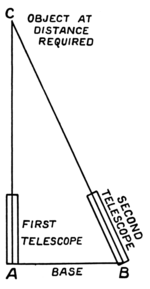with it, which does nearly as well). The base may be a few feet long, or some miles, or many millions of miles, according to the distance to be measured: but we must know its length before we can measure the distance required. Then the two telescopes at the ends are pointed at the Moon (or other object at the distance to be measured), and we see how much they "squint." Some
people may tell you that the proper word for this is the Greek word "parallax": but we will be content to use the good old English word "squint."
Let us try an actual experiment to see how a distance is determined by this squint. To save time we will put all the squint in one eye; that is to say, we will have one telescope (Fig. 9) not squinting at all, but pointing straightforwards from the base AB to the point C. We must measure the length of the base AB with this tape measure, and we will make it just 12 feet, putting the other telescope at B just 12 feet from A. Instead of telescopes, however, through which only one person can look at a time, we will have small searchlights which will make the direction visible to every one. You can all see when the searchlight B is pointed so as to throw its light on to C. To save us time in measuring the different distances I have had various positions of C marked

